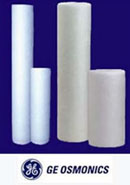About Water - Water Glossary
CHLORINE- Widely used in the disinfection of water and as an oxidizing agent for organic matter, iron, hydrogen sulfide, etc. It is available as a gas, as a liquid in sodium, hypochlorite, or as solid in calcuim hypochlorite. In water chlorine reacts with organics to form trihalomethanes (THM) which can cause cancer.
CHLORINATOR- A mechanical device specifically designed to feed chlorine gas or pellets, or solutions such as hypochlorides, into a water supply in proportion to the flow of water.
COLIFORM BACTERIA- A group of organisms primarily found in human and animal intestines and wastes, and thus widely used as indicator to show the presence of such wastes in water and the possible presence of pathogenic (disease producing) bacteria.
CONTAMINATION- The addition of any physical, chemical, biological or radiological substance to water which reduces the value of the water, or interferes with its intended use.
CORROSION- The destructive disintegration of metals by electromechanical means. Corrosion of iron and steel is commonly called rusting.
CONDUCTIVITY- The ability of an aqueous solution to carry electric current depends on the presence of ions in the solution. Conductivity is a quantitative measure which describes this ability. Solutions of inorganic ions are relatively good conductors (and exhibit high conductivity), whereas solutions of organic molecules are rather poor conductors (and exhibit low conductivity). Highly purified water is also a poor conductor. Conductivity is expressed in units of Siemen/cm (previously known as mhos/cm). Conductivity measurements are typically encountered in monitoring the performance of reverse osmosis equipment. Conductivity is temperature dependent and should be measured with a tempearautre-compensated meter. or inorganic matter will scatter the light from an incident.
1 2 3 4 5 6 7 8

